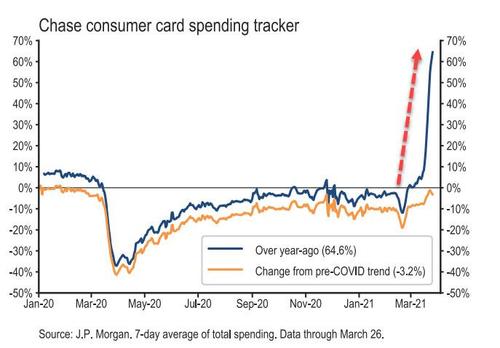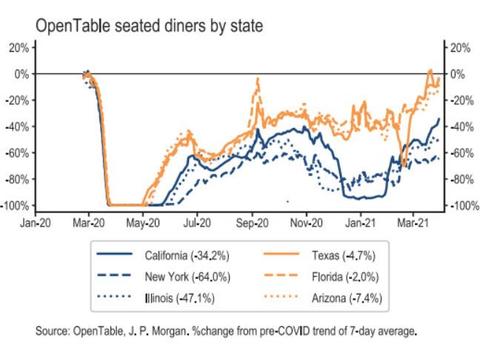The world's top economic officials plan to confront at a virtual meeting this week the prospect of new Covid-19 variants and shutdowns undermining the global rebound and weigh measures to prevent lasting damage to the poorest and most vulnerable populations.
The international economy is recovering faster than many economists projected just weeks ago, powered by growth in the U.S. and China and by the accelerating pace of Covid-19 vaccinations in many rich countries. Yet a new wave of lockdowns -- from Europe to Canada -- is threatening that growth, as many low- and middle-income nations with limited financial resources lag behind.
"The window of opportunity is closing fast," said Kristalina Georgieva, managing director of the International Monetary Fund, co-host with the World Bank of the gathering, in previewing the issues facing central bankers and finance ministers. "The longer it takes to speed up vaccine production and rollout, the harder it will be to achieve these gains," she said.
In a report to be released on Tuesday, the IMF plans to raise its forecast for global growth for this year, from the 5.5% expansion projected in January, Ms. Georgieva said in her presentation Wednesday. That would follow an estimated 3.5% contraction in 2020, the worst peacetime outcome since the Great Depression.
The annual spring meeting of the IMF and the World Bank will be held virtually between April 5 and 11, bringing together policy makers from the Group of 20 nations and others. The pandemic response, including vaccine distribution and aid to struggling nations, is expected to dominate the conversations this year. Officials will also discuss ways to rebuild the global economy, with a particular focus on strengthening the resilience against climate change.
The recovery under way is in large part a result of the roughly $16 trillion in fiscal stimulus and liquidity injections from governments and central banks, primarily in wealthy nations, the IMF said. The U.S. government alone has pledged roughly $5 trillion in stimulus spending since the pandemic began.
The IMF in January projected 5.1% growth this year in the U.S., but private forecasters have since boosted their forecasts to 7% or more, following the March enactment of a new $1.9 trillion stimulus package. China, which more quickly brought the pandemic under control to resume production and exports, was forecast to grow 8.1%.
At the same time, one mounting risk to the economic outlook is the emergence of virus variants. Three identified first in the U.K., South Africa and Brazil have since spread around the globe. All share worrisome features that threaten to undo progress in beating back the pandemic, if the virus is left unchecked.
Researchers say there is convincing evidence these variants and their descendants are more transmissible than older versions of the pathogen. Already they are sparking new outbreaks and growth-sapping public-health responses. The U.K. is only now beginning to ease its way out of a lockdown in place since January. French President Emmanuel Macron announced a new national lockdown this past week, citing surges in cases attributed to these more infectious variants.
In Canada, Ottawa saw a record number of cases on Saturday, and Ontario maintains restrictions that have closed restaurants, gyms and personal-care services for weeks. Brazil and India have seen sharp increases in cases.
In the U.S., states are easing restrictions, as the vaccine rollout has accelerated. But with the number of new cases on the rise due in part to variants, officials have cautioned about a possible surge.
Some lab studies have suggested that the current crop of vaccines might lose some of their potency when faced with the South Africa and Brazil variants especially. The worry is that the virus will chance upon new mutations that can help it evade our vaccine-acquired immunity and seed new outbreaks that prompt governments to once again shut down chunks of their economies.
Scientists are broadly optimistic because the vaccine technologies being deployed against the virus -- and our own immune systems -- are capable of adapting too. Still, the emergence of these variants, scientists say, reinforces the need to snuff out chains of transmission and vaccinate as widely as possible to give the virus fewer chances to replicate, acquire advantageous new mutations and come roaring back.
"This will be like a real-world evolution experiment: Can the variants beat the vaccines?" said Alex Sigal, who leads a team of researchers who have been probing coronavirus variants at the Africa Health Research Institute in South Africa.
Even before the new worries about the variants, global policy makers have worried about growing disparities in the world economy this year. In emerging and developing countries, the Covid-19 crisis has reduced per-capita gross domestic product by one-fifth -- nearly twice the loss among advanced economies, the IMF estimates. Last year, more than 100 million people, mostly in South Asia, fell into extreme poverty, defined as living on less than $1.90 a day. Globally, six million children could drop out of school this year, clouding their future prospects, the IMF says.
"Economic fortunes are diverging," said Ms. Georgieva. "Vaccines are not yet available to everyone and everywhere. Too many people continue to face job losses and rising poverty. Too many countries are falling behind."
Money to aid poor nations has been limited, as major economies focused on fighting the pandemic and repairing their own economies. The Group of 20 major economies has provided $5 billion in debt-service relief for more than 40 low-income nations, but private-sector lenders haven't joined the effort. The external debts of low-income countries more than doubled between 2010 and 2019, to more than $750 billion, according to the Institute of International Finance.
"Rich governments have been able to approve trillions of dollars in stimulus packages for businesses, for cash transfers for people, vaccines, and for education, but what about lower- and middle-income countries?" asked Nadia Daar, head of the Washington office of Oxfam International. "The financial response the world has provided has just not been sufficient."
To tackle the problem without adding to that burden, the IMF has proposed issuing $650 billion in SDRs, which could be exchanged for dollars or other hard currencies to cover obligations. Critics say that is an inefficient way to help poor nations because most of the SDRs will be given to rich countries that are the largest IMF shareholders. Republican lawmakers in the U.S. also say the issuance could aid repressive regimes and state-sponsored terrorism.
In response to those objections, the U.S. Treasury Department said Thursday that advanced economies are pursuing ways to lend some of their SDRs to low-income countries. The Treasury also said the U.S. can refuse to swap dollars for SDRs of countries whose policies diverge from U.S. interests.
Concerns are also emerging over the possible negative effects of the massive stimulus spending by the U.S. and other wealthy nations on the developing world. Stimulus could stoke inflation, prompting central banks to raise interest rates, thereby boosting the debt burden for countries.
"One big question, which is common to all economies, is how quick should the withdrawal of the stimulus be, and what happens when they are withdrawn and whether you'll see an increase in bankruptcies," said Odile Renaud-Basso, president of the European Bank for Reconstruction and Development, in an interview. She added that so far, the global economy has shown enormous resilience.
Federal Reserve Chairman Jerome Powell has repeatedly said he doesn't anticipate changing the central bank's easy monetary policy soon. Even so, the yield on the benchmark 10-year Treasury note was 1.72% late last week, up from 0.91% at the end of last year, on signs of an accelerating economic rebound but remains low by historical standards.
Rising U.S. yields have drawn capital away from emerging markets, putting downward pressure on their currencies while fueling both inflation and future inflation fears. Last month, Turkish President Recep Tayyip Erdogan ousted the country's central bank governor, who had raised interest rates repeatedly in an effort to tame inflation.
https://www.marketscreener.com/news/latest/Nations-Begin-to-Shape-Post-Covid-Global-Economy-Amid-Diverging-Fortunes-2nd-Update--32883938/

